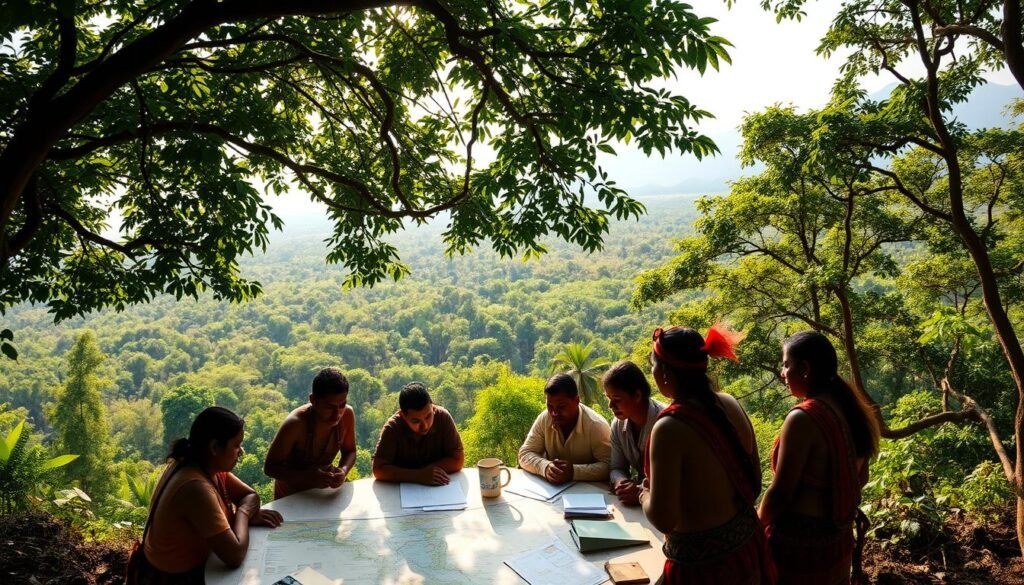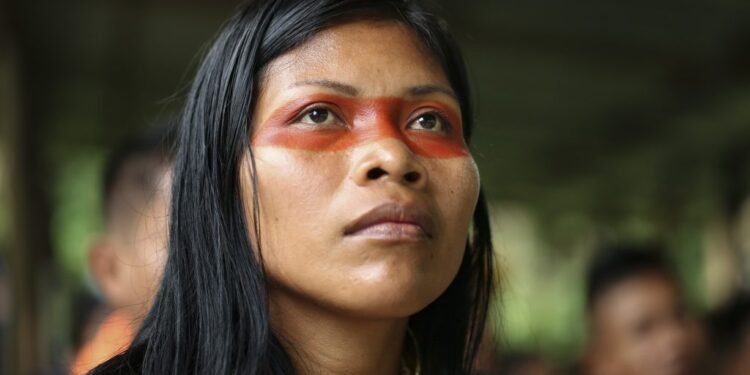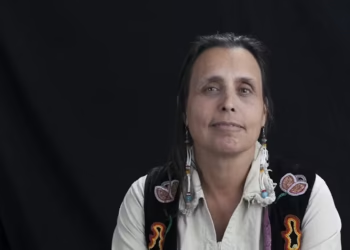What if one person’s dream could change the fate of an entire world? Nemonte Nenquimo, a Waorani leader from the Amazon rainforest, did just that. Her work proves that indigenous peoples hold the key to saving our planet.
This remarkable woman co-founded groups like Amazon Frontlines. She led a legal fight that protected half a million acres of land from oil drilling. Her victory set a new standard for resistance.
Nenquimo’s message about nature and rights has reached global audiences. She earned a spot on the TIME 100 list and won a UN environmental award. Her story shows why life in the forest matters to all people.
Key Takeaways
- Nemonte Nenquimo is a leading voice for Indigenous rights and Amazon protection.
- She co-founded important organizations to support rainforest communities.
- Her legal success in 2019 blocked oil drilling on 500,000 acres of ancestral land.
- She has received international recognition, including from TIME and the United Nations.
- Her efforts highlight the critical role of Indigenous leadership in environmental justice.
- Nenquimo’s work challenges destructive practices and offers a vision for harmony with nature.
- Her story inspires global conversations on land rights and ecological preservation.
Introduction: A Voice for the Amazon
Born into the Waorani nation, Nemonte Nenquimo carries multiple meanings in her name. These translations – “constellation of stars,” “long fish of the broken river,” and “singing bird” – reflect her deep connection to nature and culture.
Who is Nemonte Nenquimo?
This remarkable woman was born in 1985 in Nemompare, Ecuador. She became the first female president of her people’s organization.
Elders recognized her potential early. They encouraged her to become a leader for her community.
Her work began locally but soon gained international attention. She fought to protect ancestral land from destruction.
Why Her Message Matters Globally
Nemonte’s voice challenges powerful oil companies and outside influences. She speaks against the damage caused by extraction and missionaries.
Her experience with cultural displacement shapes her message. She shows how indigenous peoples protect vital ecosystems.
The book “We Will Be Jaguars” shares her story of resistance. Co-authored with Mitch Anderson, it educates the outside world.
Her advocacy matters for all people concerned about climate change. Indigenous leaders like her offer solutions for our planet’s future.
Early Life and Cultural Roots
Deep within the Amazon rainforest, a young girl’s childhood was shaped by powerful female role models and ancient traditions. This environment fostered her connection to both nature and community from earliest memory.
Growing up in the Waorani Nation
The Waorani people maintained a matriarchal society where women held central roles. They led in warfare, peace negotiations, and economic decisions.
This structure provided strong female leadership examples. Young girls learned that women could be powerful leaders in all aspects of life.
Elders recognized potential in the young woman who would become a prominent leader. They nurtured her understanding of traditional culture and connection to the land.
First Encounters With Oil Industry Impacts
At age twelve, she visited relatives living near oil operations. This experience revealed the harsh reality of industrial destruction.
She witnessed constant noise, flaming gas flares, and contaminated waterways. The oil extraction disrupted both the environment and social harmony.
This firsthand exposure to oil companies‘ impact created a turning point. It showed how external industries could damage both nature and culture.
Matriarchal Traditions and Leadership Development
Historical context matters for understanding this story. Since the 1960s, missionary groups and government actions pushed into Waorani land.
These outside forces sought to change traditional ways of life. They often worked alongside oil interests seeking access to resources.
Matriarchal values taught that women should lead in protecting community and land. This foundation shaped her understanding of resistance against destruction.
The experience of seeing both traditional life and industrial damage created a powerful contrast. It showed how environmental violence connects directly to cultural erosion.
This early life experience built the foundation for her future work. It created a determined leader who understood what was worth fighting for.
The Book as an Act of Resistance
In 2024, a powerful book emerged as a new form of resistance. “We Will Be Jaguars” represents a bold reclamation of indigenous voice and perspective.
This work challenges decades of narratives told by outsiders. It offers an authentic window into Waorani culture and worldview.

Writing “We Will Be Jaguars” with Mitch Anderson
Mitch Anderson brought his own experience with Amazon oil contamination to the project. He understood the importance of supporting rather than speaking for indigenous voices.
The writing process became a sacred exchange. Anderson listened to stories by the fire while Nemonte Nenquimo guided the content.
This collaboration ensured every word reflected authentic Waorani perspective. The woman leader maintained control over her people’s narrative.
Reclaiming Indigenous Storytelling
For too long, anthropologists and missionaries shaped the world’s understanding of indigenous peoples. Their accounts often missed the deeper truth.
This book breaks that pattern completely. It shares intimate stories from within the culture itself.
Readers gain a true sense of connection to the land and nature. The words carry the weight of lived experience rather than observation.
Breaking the Pattern of Outsider Narratives
The work directly confronts historical misrepresentations. It challenges the outside world to listen rather than assume.
Through personal story and shared dreams, the book builds bridges of understanding. It shows why indigenous leaders must control their own narratives.
This act of resistance through storytelling creates lasting change. It educates about climate justice while honoring cultural truth.
Nemonte Nenquimo’s Legal Victory Against Oil Extraction
The courtroom became a new frontier for protecting ancestral territories from industrial destruction. This legal battle represented a strategic shift in indigenous resistance strategies.
The 2019 Landmark Lawsuit
Nemonte Nenquimo co-filed the lawsuit with Ecuador’s human rights ombudsman. They challenged government plans to auction Waorani land to oil companies.
The case argued that the state violated constitutional rights. It specifically addressed the lack of free, prior, and informed consent.
Protecting Ancestral Territory
The court’s ruling protected 500,000 acres of pristine Amazon rainforest. This area represents vital cultural and ecological space for the Waorani people.
This legal victory blocked all oil extraction activities in the protected zone. It preserved both biodiversity and traditional ways of life.
Establishing Legal Precedents
The verdict established a crucial requirement for indigenous consent before land auctions. This set a powerful legal precedent across Ecuador.
Other indigenous groups quickly referenced this case in their own struggles. It created new protection standards against destructive industries.
Communities celebrated this victory as a landmark achievement for indigenous rights. The Waorani people gathered in Puyo to honor this historic moment.
This legal success demonstrates how strategic litigation can protect both people and nature. It shows the power of combining traditional knowledge with modern legal systems.
The case represents a significant step in the broader struggle against extractive industries. It proves that determined resistance can achieve meaningful protection for vulnerable ecosystems.
Gender Dynamics and Environmental Violence
Industrial activities create deep social wounds that mirror ecological damage. When extractive operations enter indigenous territories, they disrupt more than just the physical environment.
How Extractive Industries Disrupt Community Balance
Oil companies typically hire men for labor jobs. This practice upends traditional Waorani gender roles.
Matriarchal structures weaken when men gain outside income. Women’s authority in community decisions diminishes over time.
These industries often introduce alcohol and new social problems. Domestic violence increases alongside environmental contamination.
The waorani people experience cultural erosion through this disruption. Their traditional way of life faces constant pressure.
The Connection Between Violence Against Women and Violence Against Earth
This remarkable woman leader draws powerful parallels in her work. She sees the same patterns of exploitation affecting both women and nature.
Both are treated as resources to be extracted. Both suffer from similar forms of destruction and disrespect.
Indigenous women have long served as caregivers and life-givers. Their experience makes them natural protectors of the land.
The struggle for environmental justice connects directly to women’s rights. This perspective shapes the resistance movement.
Indigenous Women’s Leadership in Conservation
Indigenous peoples increasingly recognize women’s vital role in protection efforts. Their leadership draws from deep cultural knowledge.
Traditional matriarchal systems inform modern conservation work. Women often manage household resources and community harmony.
This woman‘s story illustrates how female leaders guide environmental fights. They bring unique perspectives to ecological protection.
Their connection to nature as life-givers fuels their determination. Indigenous women continue leading the charge for cultural and environmental preservation.
Co-Founding Amazon Frontlines and Ceibo Alliance
Strategic partnerships often emerge from shared commitment to urgent causes. This proved true when dedicated activists joined forces to create powerful organizations for Amazon protection.

Meeting Mitch Anderson and Building Partnerships
In 2013, a significant meeting occurred during water quality work. The indigenous leader connected with environmental activist Mitch Anderson.
They collaborated on addressing oil contamination in local water sources. This shared experience revealed their aligned vision for change.
Their partnership blended traditional knowledge with modern activism. This combination proved powerful for addressing complex environmental challenges.
Creating Indigenous-Led Conservation Organizations
The Ceibo Alliance formed in 2014 as a groundbreaking initiative. It united indigenous peoples across three Amazonian countries.
This organization provided collective representation against external threats. It empowered communities to protect their ancestral land and culture.
Amazon Frontlines emerged later with expanded focus areas. Its mission combined legal defense, conservation work, and technological innovation.
Both organizations maintained indigenous leadership at their core. This ensured authentic representation of Amazonian peoples‘ needs and perspectives.
Water Projects and Community Organizing
The Clear Water project addressed immediate health concerns from contamination. It installed rainwater harvesting systems in affected communities.
This practical solution provided clean drinking water where oil operations had polluted sources. It demonstrated tangible improvements in people‘s daily life.
Community organizing efforts strengthened local resistance capabilities. They trained indigenous leaders in mapping, monitoring, and advocacy skills.
GPS technology helped communities document territorial boundaries. This evidence supported legal fights for land protection.
These initiatives showed how practical work supports broader environmental fights. They connected immediate needs with long-term conservation goals.
Confronting Global Systems: Capitalism and Colonialism
Global economic systems often clash with ancient wisdom about living in balance. Indigenous voices offer powerful critiques of how modern development harms both people and planet.
These perspectives challenge the very foundations of extractive economies. They propose alternative ways of relating to the natural world.
Indigenous perspectives on extractive economies
For many indigenous peoples, capitalism represents a continuation of colonial thinking. It treats land and resources as commodities rather than relatives.
Oil companies embody this extractive mindset perfectly. They see forests as profit sources rather than living ecosystems.
This approach creates lasting destruction that affects entire communities. The struggle against these forces becomes a fight for survival.
The spiritual connection to Mother Earth
Traditional indigenous culture views nature as Mother Earth. This relationship involves reciprocity rather than extraction.
The forest provides everything needed for life and sustenance. People care for the land as they would care for family.
This spiritual connection shapes daily experience and worldview. It creates a deep sense of responsibility toward future generations.
Challenging Western development models
Western models often prioritize material wealth over ecological health. This creates what some call a “sickness of the mind” in modern society.
People become disconnected from nature and community. The outside world focuses on growth without considering consequences.
Indigenous leaders offer different visions for human progress. Their story emphasizes harmony rather than domination.
This remarkable woman leader argues that true development means caring for all life. Her resistance work challenges systems that cause suffering.
Through activism and education, she promotes healing and reconnection. Her message invites the world to learn from indigenous wisdom.
Current Threats and Conservation Efforts
The Amazon faces a critical moment in its long history. Scientists warn that deforestation has reached dangerous levels. The rainforest could turn into dry savannah within two decades.
This change would affect the entire planet. The Amazon creates weather patterns and stores carbon. Its loss would accelerate global climate change.
The Amazon’s Tipping Point: Deforestation Concerns
Research shows that 25% deforestation could trigger irreversible damage. The forest needs its own rainfall to survive. Without enough trees, the whole system collapses.
Indigenous peoples face cultural genocide if this happens. Their entire way of life depends on the healthy forest. They have protected this land for generations.
The struggle involves more than environmental concerns. It represents a fight for cultural survival. These communities defend both nature and their ancestral traditions.
Indigenous-Led Protection Strategies
Organizations like Amazon Frontlines use multiple approaches. Legal actions help establish land rights. Community organizing builds local resistance capacity.
Technology plays an important role in modern conservation. Drones monitor illegal logging activities. GPS mapping documents traditional territories.
These strategies combine ancient knowledge with modern tools. Indigenous leaders guide every decision. Their experience with the land informs protection efforts.
Cultural Preservation and Regenerative Economies
Conservation work includes cultural education programs. These efforts decolonize learning materials. They celebrate traditional knowledge and languages.
Regenerative economies offer sustainable alternatives. They create income without destroying nature. Forest products like nuts and oils provide livelihoods.
This approach honors the connection between people and place. It builds economic systems that work with nature. These models show how humanity can thrive without causing harm.
The work continues despite growing threats. Every protected acre represents a victory. Each legal precedent strengthens the broader resistance movement.
Vision for the Future: Dreams and Hopes
Looking ahead brings powerful visions of change and renewal. A remarkable indigenous leader shares her deepest hopes for humanity’s relationship with the planet.
Her message reaches beyond immediate struggles. It paints a picture of what could be when people awaken to their connection with all life.
Awakening Global Consciousness
Nemonte Nenquimo believes stories can transform how people see the world. Her book carries this hope to readers everywhere.
She dreams of awakening spirits through shared experience. This indigenous woman wants others to feel the forest’s heartbeat.
Global consciousness means recognizing our shared destiny. All people depend on the same air, water, and earth.
Healing Connections With the Earth
Western systems created deep disconnection from nature. Healing this relationship becomes urgent work for our time.
Indigenous cultures never lost this sacred bond. Their way of life offers wisdom for reconnecting with the natural world.
This healing involves changing how we see the earth. Instead of resource, it becomes relative and home.
Women’s Leadership in Global Change
Women across cultures carry trauma from environmental violence. Uniting them creates powerful force for change.
Female leaders bring unique perspectives to protection work. Their experience as life-givers informs their approach.
This vision calls for women to lead the way forward. Not waiting for governments or corporations to act first.
Civil society must take leadership roles now. Everyday people can drive the change needed for a sustainable future.
This hope ties into broader movements for justice. Indigenous rights and environmental protection connect deeply.
The dream remains alive through continued action and hope. Each person can contribute to this vital work.
Conclusion: The Ongoing Struggle for Amazon Protection
The fight for the Amazon rainforest continues. Indigenous leaders and communities work hard every day. They protect their land and culture from oil drilling and deforestation.
This struggle is about more than trees. It is about the way of life for many peoples. Their work helps the whole world fight climate change.
Support from groups like Amazon Frontlines gives hope. They help women and people stand strong. Everyone can join this important story of protection.
FAQ
Who is Nemonte Nenquimo?
Nemonte Nenquimo is an Indigenous Waorani leader and environmental activist from the Amazon rainforest in Ecuador. She co-founded the Ceibo Alliance and Amazon Frontlines, organizations dedicated to protecting Indigenous rights and territories. In 2020, she was named one of Time magazine’s 100 most influential people for her groundbreaking work.
What was her landmark legal victory?
In 2019, Nemonte Nenquimo led a successful lawsuit against the Ecuadorian government, which resulted in the protection of 500,000 acres of Waorani ancestral territory from oil drilling. This case set a critical legal precedent for Indigenous land rights not only in Ecuador but across the Amazon.
Why is her leadership significant for environmental conservation?
Her leadership demonstrates the powerful role Indigenous communities play in protecting biodiversity. By defending their lands from extractive industries, leaders like Nemonte Nenquimo help preserve vital ecosystems that regulate the global climate and house immense biological diversity.
How does her work connect Indigenous rights and women’s empowerment?
Nemonte Nenquimo highlights how environmental destruction often exacerbates violence against women and disrupts community balance. Her leadership reflects a broader movement of Indigenous women asserting their roles as guardians of culture, land, and future generations.
What organizations did she help establish?
She co-founded the Ceibo Alliance, an Indigenous-led organization focused on cultural revival and land defense, and Amazon Frontlines, which partners with Indigenous communities to protect their rights and territories through legal, narrative, and on-the-ground strategies.
What is the message of her book, “We Will Be Jaguars”?
Co-written with Mitch Anderson, the book reclaims Indigenous storytelling and challenges outsider narratives about the Amazon. It frames resistance as a spiritual and cultural imperative, emphasizing the deep connection between Indigenous peoples and their ancestral lands.
How does Nemonte Nenquimo view Western economic models?
She critiques capitalist and colonial systems that prioritize extraction over life, arguing that these models threaten both ecological stability and human well-being. She advocates for Indigenous worldviews that emphasize reciprocity with nature and community-led stewardship.
What are the biggest threats the Amazon currently faces?
The Amazon confronts deforestation, oil extraction, mining, and land invasions. These activities push the rainforest toward a tipping point of ecological collapse, endangering global climate systems and the survival of Indigenous cultures.
What is her vision for the future?
Nemonte Nenquimo envisions a world where humanity awakens to its interdependence with nature, where Indigenous knowledge guides global conservation efforts, and where women lead the way in healing relationships with the Earth.





